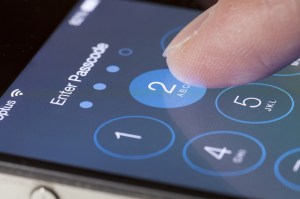The problem with a company as prescriptive about what it builds as Apple is that those choices often run counter to the rest of the tech industry—a point often highlighted at events like the one it held yesterday, where it announced four variants of the iPhone 13 that feel awful similar to the ones released a year ago.
And that can leave out customers along the edges who might want an iPhone-like experience, but are holding back because of one or two specific features that Apple seems not to want to bend on.
Videos by VICE
Some people will avoid buying an iPhone because they want a device that unlocks with their fingerprint because face detection skeeves them out. Others would like to skip the annoyance of having a phone that’s incompatible with every cable they already own. And then there are others who don’t really care about having a cellular signal because they mostly use the phone in Wi-Fi environments anyway.
And strangely enough, Apple may have accidentally built a device that addresses many of these users’ concerns. They just have to think differently about how they hold the iPad Mini.
Yes, it’s being sold as a small tablet, but there is a strong case that the latest edition iPad Mini might be better appreciated as a gigantic phone.
Cost-wise, there is actually a lot to support the case for an iPad Mini becoming a phone alternative for a lot of people. One place to start is price: While the starting price of the just-announced iPad mini is $499 and does not come with cellular, if you add 5G cellular and go with the 256-gigabyte option, it ends up being the exact same price as an iPhone Mini with the exact same storage option.
Sure, the screen isn’t OLED (though Liquid Retina is quite good for an IPS-based LCD panel) and you’re giving up better cameras in exchange for the larger screen, but its feature set is quite strong for certain classes of users.
For one, folks who like security will find a lot to like about a device that has Touch ID baked in rather than something that relies on cameras. Apple has worked hard to convince the technology-buying public that Face ID is where it’s at, but concerns about its security when it counts have lingered. As a result, some people have really just wanted access to a fingerprint-based login mechanism instead, which Apple has relegated to older or low-end models.
For those that are really into security and don’t want a cellular signal at all for their communication mechanism, the new iPad Mini looks like a massive upgrade from the only other phone-adjacent device that Apple sold that this market could really use, the iPod Touch. As pointed out by the privacy-focused blog Yawnbox, the iPod Touch, last upgraded in 2019, has a processor that is extremely outdated (the A10 Fusion, which first appeared in the iPhone 7 in 2016), making it outdated against certain kinds of attacks.
But even for those who aren’t making purchasing decisions based on secure messaging needs, the sixth-generation iPad mini looks to be a great choice for those who float between multiple ecosystems. I would count myself as one of those people, using a OnePlus phone as my primary device. But I also have a variety of laptops and other devices, including e-readers, nearly all of which accept USB-C input. The fact that Apple has ignored the pleas of the industry to ditch the proprietary Lightning connectors—despite the fact that its own keynote on Tuesday let slip that USB-C is actually significantly faster at data transfer than Lightning—is unconscionable at this point, especially given the fact that the iPhone is being pitched for professional use cases.
But because the iPad ecosystem now mostly offers USB-C as its primary port, it opens the device up for opportunities to plug in high-speed devices like portable SSD drives. Thanks to the port, it’s even possible to connect a Raspberry Pi to an iPad, allowing its use as a portable development environment.
For this reason, when I made the decision to buy a mobile Apple device earlier this year, I went with a used iPad Pro—not because I wanted the screen real estate, but because I didn’t want Lightning. If the latest version of the iPad Mini was around, that would have proven a very compelling option.
So the reasons for using an iPad Mini as your next phone—you arguably get more for your money, it offers an industry-standard port, it’s potentially a great choice for secure communications, and there’s no notch—seem strong on paper. But nonetheless, there’s the potential that this could potentially get a little quirky. There are differences between iPadOS and iOS that have grown over the years, which make the experiences a little different (which can be good in some cases, such as multitasking). But this also cuts both ways. For one thing, Apple officially requires an iPhone to dial out of an iPad, though options like Google Voice exist as alternatives. But given the fact that so much communication happens outside of a phone interface anyway (and most of the phone calls you’re getting are likely robocalls), you may find that you don’t miss it so much.
Finally there are app-specific quirks. In particular, Instagram seems allergic to the idea of anyone actually using its popular social network on an iPad, only offering an awkward blown-up iPhone app equivalent for users who insist on not using a smartphone. Some, like the dialer app Sideline, specifically choose not to support the iPad. Depending on your use case, you might find yourself out of a few apps you rely on with your iPhone.
But all in all, the new iPad Mini model is looking pretty compelling for people who primarily use their phones for non-phone things, even if its large size, roughly twice that of the iPhone 13 Pro Max, makes it somewhat less pocketable.
It could be a style opportunity, if you think about it: It’s a great excuse to start wearing trench coats everywhere.
More
From VICE
-

Screenshot: ConcernedApe -

Collage by VICE -

Collage by VICE -

NSW Ambulance

